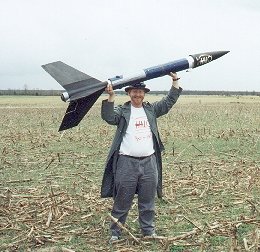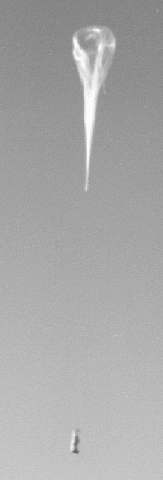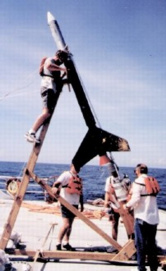Project HALO (High-Altitude Lift-Off)
Where Learning Can be Fun and Make an Impact

Blah blah...Mass Fraction...blah blah...ISP...blah blah...Fire and Smoke...Awesome...

Where Learning Can be Fun and Make an Impact

Blah blah...Mass Fraction...blah blah...ISP...blah blah...Fire and Smoke...Awesome...
Getting to Space on the Cheap
After the success of ISDC 1993 here in Huntsville, HAL5 began its biggest project ever in 1994, Project HALO (for "High-Altitude Lift-Off"). The goals of the project are no less than to provide cheap access to space for small clubs and student groups. We selected a hybrid propulsion system. Hybrid rockets operates by burning solid with liquid oxidizer. They can be throttled, and shut off and restarted in flight.
On May 11, 1997, HAL5 made amateur rocketry history when it successfully performed its first hybrid rockoon mission, dubbed Sky Launch 1. We launch SL-1 from a grass strip airfield just north of Hampstead, North Carolina, about a mile west of Topsail Beach. The balloon was over 50,000 feet above the Atlantic Ocean when the rocket was fired. The HALO SL-1 rocket ascended to approximately 36 nautical miles. HALO that day conducted the world's first high altitude ignition of a hybrid rocket. It is the highest flight of a hybrid rocket at that time. That day, HAL5 proved to the world that small groups can accomplish great things and made space a little closer to all of us.
The record made into the 2000 Guinness Book of World Records under Amateur Rocketry. Due to avionics glitches, no accurate altitude was recorded. However, Greg Allison (former Project HALO Manager) indicated that the balloon's camera showed the curvature of the earth and "black sky," Some believed we were a lot higher than 36 miles. HAL5's record stood until 2004 when Civilian Space eXploration Team (CSXT) achieved 72 miles.
SL-1 and subsequent attempt of SL-2, and indirect involvement with Space Frontier Foundation - CATS Prize, peeked interests in a lot of folks. If high altitude ignition and hybrid rocket sounds familiar, well, it should. HAL5 did not invent rockoon or hybrid rocket, but we took the ideas, combined them, and made it more interesting. Thus, if you trace our engineers' work and influences, HAL5's demonstrated technology, including our use of common bulkhead for the hybrids, made it to SpaceShipOne and SpaceShipTwo.
Before this launch, we have static fired a lot of hybrids in attempt to find the right propellant compound ingredients and characterized the burn characteristics. But GL-1 was our first integrated test of the an actual flying rocket and gondola (air launch pad). The test was held on Saturday, April 13, 1996 at the Barrens Test Range in Manchester, Tennessee.

Who said 13 was an unlucky number? There we stood in a windswept cornfield near Manchester, Tennessee on Saturday, the 13th of April, with the HALO rocket stowed in its launch gondola in the back of Al Wright's pickup truck. Wind gusts were so bad that the local volunteer fire department, which was running a barbecue concession for the event had to take down their canopy. Then, a heavy rainstorm swept in followed by more wind. The wind was almost steady with a few breaks of just four or five minutes. Our launch window was only open from 2 to 4 pm. Launch conditions did not appear to be optimal. [ Read More ]

After the success of GL-1, Project HALO kicked into high gear for our first launch
attempt on March 22, 1997. Due to prelaunch malfunction, launch first attempt was scrubbed.
The second attempt, on May 3 was scrubbed due to weather.
Finally...HAL5 made amateur rocketry history on Sunday, May 11, 1997 from Hampstead, North
Carolina,
[34.39639, -77.665].
At 8:25 AM EDT, HAL5's Project HALO team
performed the first amateur rockoon mission when it successfully launched its
Sky Launch 1 rocket from a high altitude balloon. HAL5 also made hybrid rocketry
history as well, becoming the first organization to launch a hybrid rocket from a
high altitude. ased on an estimated rocket apogee between 30 and 36
nautical miles, HAL5 can now claim the world record for highest
altitude achieved to date by an amateur rocket -- and by a hybrid
rocket of any kind. [ Read More ]

After the success of SL-1, Project HALO team got back to the garage and prepare our next launch. On June 20, 1998, HAL5 attempted its first mission for Phase 2 of Project HALO, a heroic effort to reach space on June 20, 1998! HAL5 attempted its first launch of a larger, more powerful, hybrid rocket on Saturday, June 20, 1998 from the Gulf of Mexico, in the first of two planned joint missions with the NASA Marshall Space Flight Center. Despite a heroic effort by the team at sea and on shore, the mission ended with a launch failure. Today, the SL-2 rocket, with its damaged fins and avionics canister, is on display at Straight to Ale's Campus 805 location. [ Read More ]
To be added.
To be added.
To be added.